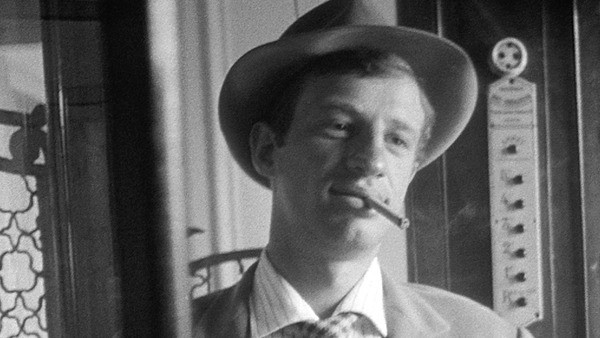Lighting is very simple within Dr Caligari as it mainly involves the stark yet deliberate contrast off dark against light and black against white. A prime example of this comes from the makeup of Cesare. As I previously explained, black is used to represent darkness and evil within his character; that of the implication that he is a murderer by the unreliable narrator of Francis. The remarkably white tint of his face stands out sharply against the black hair, makeup and background. White and black are interesting colours to contrast because they are considered opposites; innocence and evil representatives. The surrounding of darkness suggests that Cesare is being affected by evil and this malevolence is slowly spreading. This interpretation can be considered corrupted by Francis’ warped mind which makes us question everything.
Shadows are actually used to show Cesare killing Alan. Throughout the film, we see Cesare as a dark, twisted character. However, by not actually showing him murder Alan, and instead using his shadows; we are given the implication or perhaps foreshadowing that he is not actually a murderer. But by this point, we do not know this so we assume that he is this evil, dark character. Murdering Alan in darkness and hidden by shadows serves as a good representation of Cesare as a dark character himself. We are led to believe this because the darkness hides his true character. Visually, the shadows contrast against the limited lighting to show the audience exactly what is happening. I don’t think the murder would be as effective if shown in broad daylight because by this, we never actually see Cesare do it; this shows that he is not truly evil to the point where Francis’ twisted memory cannot even conjure the image of him murdering Alan

Another main focus of lighting, is that of the contrast between light and dark. Most of the characters wear black, or dark colours aside from Jane. This stands out against the brighter lights and interior designs which are typically white or grey as seen in the picture. Since the characters are usually depicted in darkness, we get the assumption that Francis perceives others as evil and not to be trusted. Since we are watching the film from his ‘flashbacks’, we assume that he is telling the truth. However, his deranged world is fiction and the characters shown in darkness are simply reimagined people from his environment. The contrast is significant to show the clear difference between the characters and the set. This can be derived from the idea that although the people themselves are real their characters created by Francis were not and we are actually not viewing an environment but instead trapped inside the warped mind of Francis
Since the film is filmed entirely within a studio, there is also the idea that there is no access to the real world and the characters are trapped within this hellish nightmare. Fear is a main feelings imposed upon the audience by the unnatural approach to the set. This is very significant in setting the mood for the rest of the film and suggesting that the characters are trapped within this world. We are given a look into the mind of Francis from his perspective since we did not know that his story is fabricated. However, this separate world is disrupted by the elements of normalcy shown through certain sets such as that of Jane’s house. This is a shortened and edited version of the essay, the rest can be found on the blog not in the film role 2 category*





